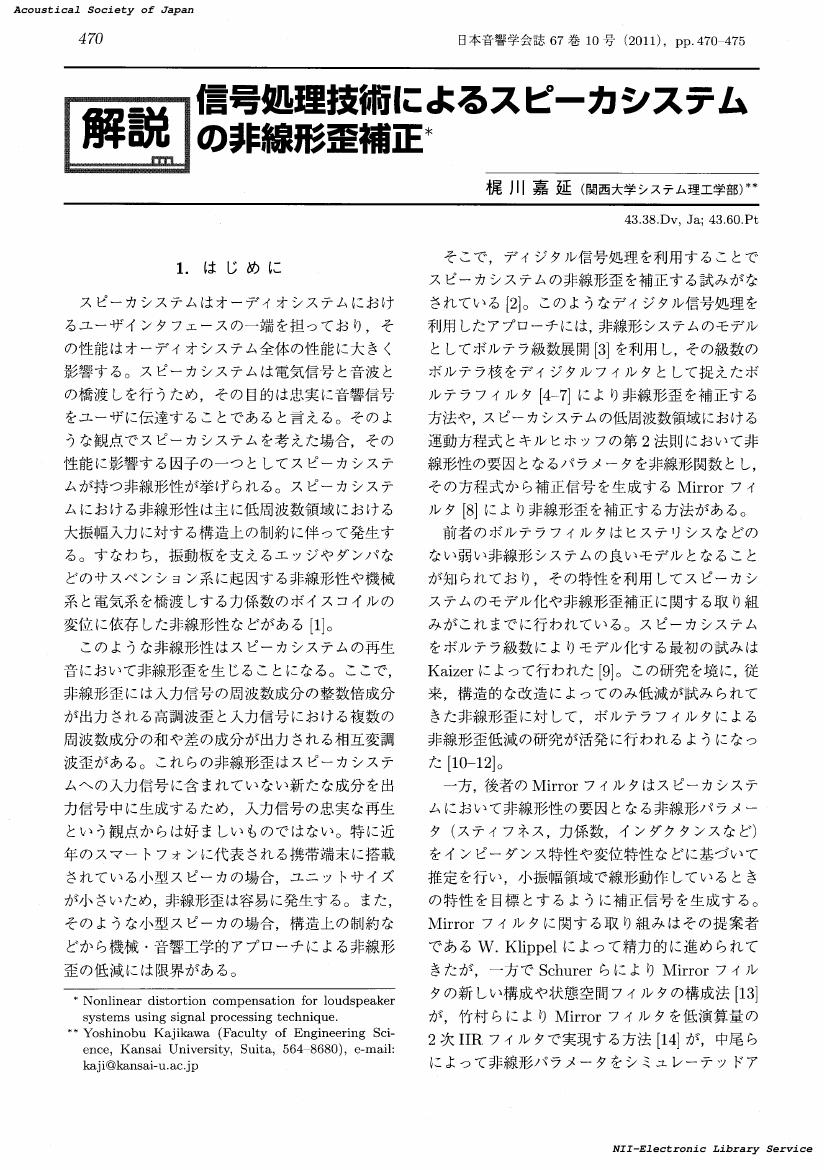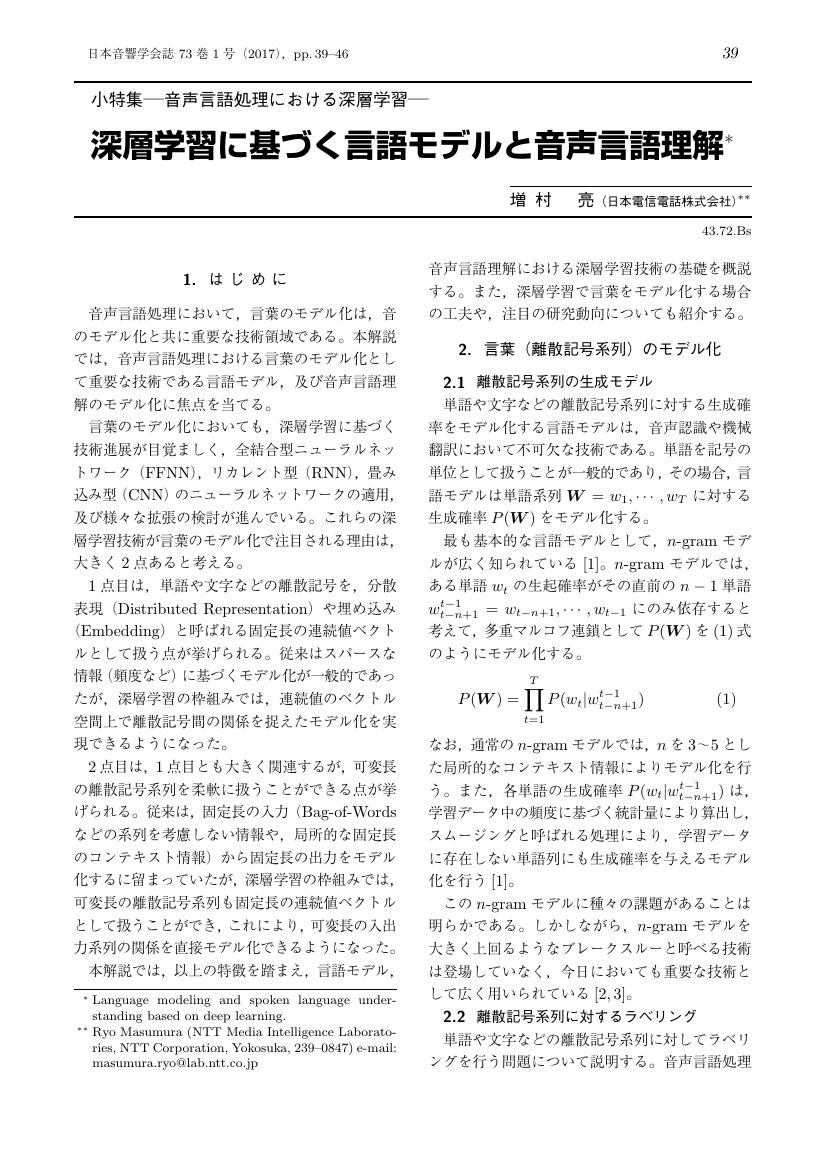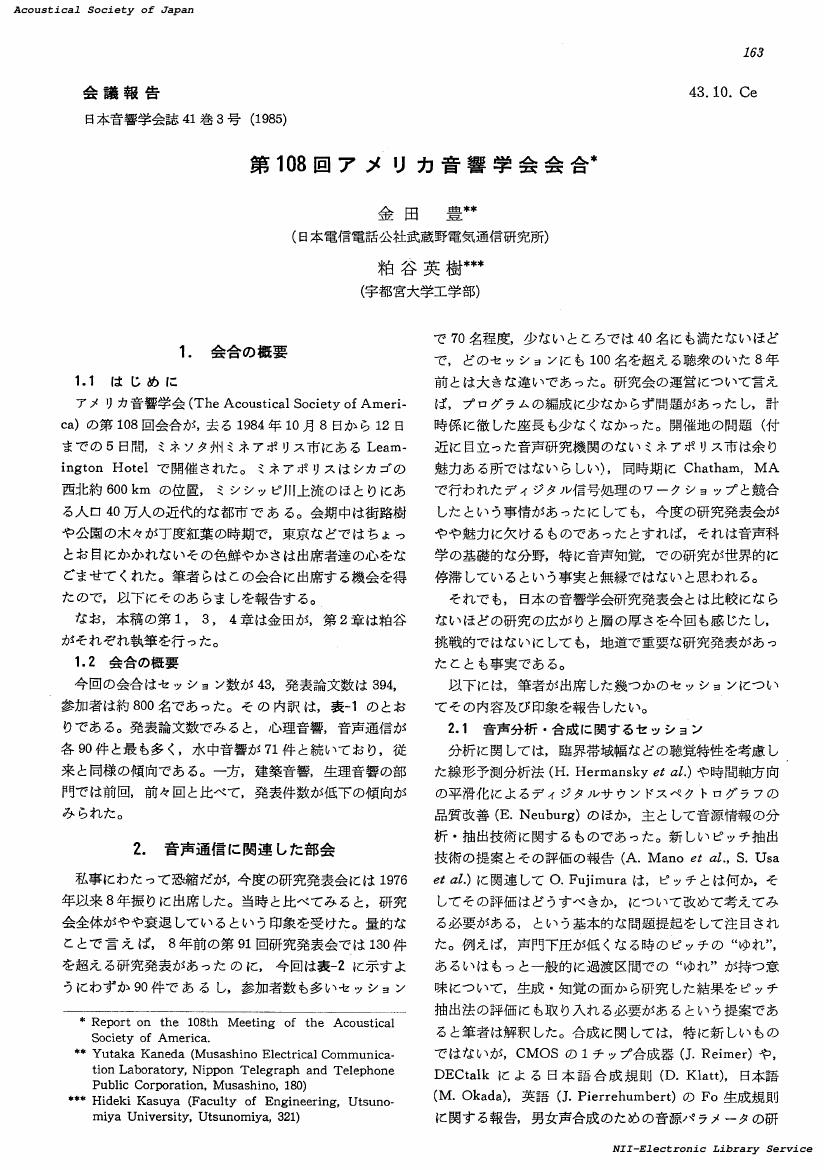1 0 0 0 OA 統計的手法による音響イベント検出
- 著者
- 林 知樹 戸田 智基
- 出版者
- 一般社団法人 日本音響学会
- 雑誌
- 日本音響学会誌 (ISSN:03694232)
- 巻号頁・発行日
- vol.75, no.9, pp.532-537, 2019-09-01 (Released:2020-03-01)
- 参考文献数
- 48
1 0 0 0 OA 深層学習に基づく音源分離
- 著者
- 亀岡 弘和
- 出版者
- 一般社団法人 日本音響学会
- 雑誌
- 日本音響学会誌 (ISSN:03694232)
- 巻号頁・発行日
- vol.75, no.9, pp.525-531, 2019-09-01 (Released:2020-03-01)
- 参考文献数
- 23
1 0 0 0 OA 音声認識における音響モデル(<小特集>自動音声認識研究の動向と展望)
- 著者
- 渡部 晋治
- 出版者
- 一般社団法人 日本音響学会
- 雑誌
- 日本音響学会誌 (ISSN:03694232)
- 巻号頁・発行日
- vol.66, no.1, pp.18-22, 2009-12-25 (Released:2017-06-02)
- 参考文献数
- 63
1 0 0 0 OA 鼻子音の識別
- 著者
- 重永 実 有泉 均
- 出版者
- 一般社団法人 日本音響学会
- 雑誌
- 日本音響学会誌 (ISSN:03694232)
- 巻号頁・発行日
- vol.21, no.5, pp.263-271, 1965-09-30 (Released:2017-06-02)
A method of recognizing /m/ and /n/ of monosyllables and words in real time is reported. The method consists of three parts; segmentation of nasal consonants, recognition of the following vowel, and discrimination between /m/ and /n/ according to the result of vowel recognition. In order to extract the nasal part, /e, a, o, u, w/ are excluded from nasals by comparing the output of 300 c/s LPF with that of 500〜1600 c/s BPF, and /i, j/ are excluded by comparing 500〜1600 c/s with 2800〜5000 c/s. Voiceless stops are easily omitted by comparing the output of 300 c/s LPF with that of 700 c/s HPF, and this circuit is also used for excluding vowels. In order to exclude the beginning and end part of /u/ more certainly, the output wave form of 400〜1000 c/s BPF is used. The parts in which the envelope of that wave varies rapidly are excluded from the nasal part. For excluding voiced stops, fricatives, and flappeds, fundamental frquency components are extracted from filtering output of 400〜1000 c/s BPF and the parts in which the fundamental frequency components exist continuously are considered to be likely nasal. The low intensity parts of original speech waves are considered to be non-nasal parts. The segment which satisfies above six conditions is decided to be nasal consonant after leaving out 12 msec of the continuum. According to this method the initial part of the nasal consonant is often missed but the boundary between the nasal consonant and the following vowel is pointed out exactly. Concerning about the discrimination between /m/ and /n/, the components of two specific frequencies are compared just before the boundary between the nasal consonant and the following vowel for distinguishing /mi/ and /me/ from /ni/ and /ne/ respectively. For the nasals followed by /a, o, u/, F_2 loci are used directly. Though /me/ and /ne/ in words are not discriminated satisfactorily by the method due to the individual variations, the others are recognized correctly over 80% for 180 samples of three male speakers.
1 0 0 0 OA 英語が話せる日本人, 話せない日本人(<小特集>外国語をはなそう!)
- 著者
- 河合 剛
- 出版者
- 一般社団法人 日本音響学会
- 雑誌
- 日本音響学会誌 (ISSN:03694232)
- 巻号頁・発行日
- vol.55, no.1, pp.45-50, 1998-12-25 (Released:2017-06-02)
- 被引用文献数
- 1
- 著者
- 谷口 高士
- 出版者
- 一般社団法人 日本音響学会
- 雑誌
- 日本音響学会誌 (ISSN:03694232)
- 巻号頁・発行日
- vol.62, no.9, pp.682-687, 2006
- 参考文献数
- 10
1 0 0 0 OA 信号処理技術によるスピーカシステムの非線形歪補正
- 著者
- 梶川 嘉延
- 出版者
- 一般社団法人 日本音響学会
- 雑誌
- 日本音響学会誌 (ISSN:03694232)
- 巻号頁・発行日
- vol.67, no.10, pp.470-475, 2011-10-01 (Released:2017-06-02)
- 参考文献数
- 28
1 0 0 0 OA 深層学習に基づく言語モデルと音声言語理解
- 著者
- 増村 亮
- 出版者
- 一般社団法人 日本音響学会
- 雑誌
- 日本音響学会誌 (ISSN:03694232)
- 巻号頁・発行日
- vol.73, no.1, pp.39-46, 2017 (Released:2017-07-01)
- 参考文献数
- 88
1 0 0 0 OA 建築物における風による音の発生とその防止
- 著者
- 北村 敏也 林 芳成 山田 聡 宮田 勝文 山田 伸志
- 出版者
- 一般社団法人 日本音響学会
- 雑誌
- 日本音響学会誌 (ISSN:03694232)
- 巻号頁・発行日
- vol.61, no.10, pp.597-603, 2005-10-01 (Released:2017-06-02)
1 0 0 0 OA サンバ演奏の動作解析(<小特集>音楽演奏者の動作解析)
- 著者
- 藤波 努
- 出版者
- 一般社団法人 日本音響学会
- 雑誌
- 日本音響学会誌 (ISSN:03694232)
- 巻号頁・発行日
- vol.67, no.9, pp.427-432, 2011-09-01 (Released:2017-06-02)
- 参考文献数
- 7
- 著者
- 河原 英紀
- 出版者
- 一般社団法人 日本音響学会
- 雑誌
- 日本音響学会誌 (ISSN:03694232)
- 巻号頁・発行日
- vol.59, no.11, pp.670-675, 2003
- 参考文献数
- 42
- 被引用文献数
- 2
1 0 0 0 OA 第108回アメリカ音響学会会合
- 著者
- 金田 豊 粕谷 英樹
- 出版者
- 一般社団法人 日本音響学会
- 雑誌
- 日本音響学会誌 (ISSN:03694232)
- 巻号頁・発行日
- vol.41, no.3, pp.163-166, 1985-03-01 (Released:2017-06-02)
1 0 0 0 OA 教師あり/教師なしスペクトル写像による声質変換
- 著者
- 松本 弘 丸山 靖史 井上 博夫
- 出版者
- 一般社団法人 日本音響学会
- 雑誌
- 日本音響学会誌 (ISSN:03694232)
- 巻号頁・発行日
- vol.50, no.7, pp.549-555, 1994-07-01 (Released:2017-06-02)
- 参考文献数
- 15
本論文は、教師あり及び教師なしスペクトル写像とパワースペクトル包絡(PSE)分析合成系に基づく声質変換法を検討している。教師つきの場合、入力話者のスペクトルは、代表スペクトルの入力・目標話者間の差を歪最小基準で内挿することによって写像される。また、教師なし方法では、目標話者の符号帳と、これをファジー目的関数最小基準で入力話者に適応化した符号帳を用い、ファジー写像を利用して変換される。変換音声と目標音声との対比較による話者識別実験で評価を行い、男声男声変換では、どちらの方法についても平均識別率84%を得た。また、男声女声変換では、教師つき方法で平均70%の識別率が得られた。
1 0 0 0 OA 音節とアクセントとリズム
- 著者
- 湯山 清
- 出版者
- 一般社団法人 日本音響学会
- 雑誌
- 日本音響学会誌 (ISSN:03694232)
- 巻号頁・発行日
- vol.11, no.2, pp.123-124, 1955-06-30 (Released:2017-06-02)
1 0 0 0 "Plus"と"Minus"のリズム : リズムの時間的関係
- 著者
- 湯山 清
- 出版者
- 一般社団法人 日本音響学会
- 雑誌
- 日本音響学会誌 (ISSN:03694232)
- 巻号頁・発行日
- vol.11, no.1, pp.33-34, 1955
1 0 0 0 OA 聴神経の順応特性の計算機シミュレーション : 順応の音圧レベル依存特性のモデル化
- 著者
- 牧 勝弘 赤木 正人
- 出版者
- 一般社団法人 日本音響学会
- 雑誌
- 日本音響学会誌 (ISSN:03694232)
- 巻号頁・発行日
- vol.67, no.2, pp.55-64, 2011-02-01 (Released:2017-06-02)
- 参考文献数
- 15
聴神経の発火頻度は,音の立ち上がりに対して高く,その後急速に低下する(順応)。この順応は音圧レベルの影響を強く受け,その特性は個々の聴神経で大きく異なっている。従来のモデルは,順応の音圧レベル依存の性質を模擬できず,複数の聴神経の順応特性を模擬することができなかった。本研究では,内有毛細胞の受容器電位の生成機構について新しい機能モデルを提案し,従来の内有毛細胞モデルとパルス列を出力する聴神経モデルを組み合わせることで聴覚モデルを構築した。モデルの出力を生理データと比較することでモデルの評価を行い,本モデルが,複数の聴神経の順応特性を,音圧レベル依存の性質まで含めて定量的に模擬できることを示す。
1 0 0 0 OA クラリネットの発音機構の基礎的研究
- 著者
- 広根 万里雄 曽根 敏夫 二村 忠元
- 出版者
- 一般社団法人 日本音響学会
- 雑誌
- 日本音響学会誌 (ISSN:03694232)
- 巻号頁・発行日
- vol.31, no.8, pp.487-495, 1975-08-01 (Released:2017-06-02)
A theory of the excitation of a clarinet was proposed in case that no performer's lips were applied to the reed of the instrument, by assuming the interaction between the air column and the reed and considering the vibration of reed as a bending vibration of beam. The results of calculation were compared with those of experiment on a model clarinet specially prepared in order to make both experimental condition and theoretical assumption coincide. In Section 2, the method of calculation of the resonance frequency of reed itself is shown ; the calculation was based on the assumption that the reed vibration is well represented by one-dimensional bending vibration of beam. Section 3 depicts the equation (Eq. (14)) of motion of the reed of instrument and the wave equation (Eq. (13)) of air column. These equations were solved simultaneously and from the results of analysis the frequency equation was obtained, which gave the dependence of the excited frequency (including higher order modes) on the physical blowing condition of the instrument. In Section 4, an example of the excited frequency calculated from the frequency equation is first shown (Fig. 7) based on presumable values of the material constants for a standard reed, together with the resonance frequency of the reed. Next, for confirming the above mentioned theoretical results, calculation was performed for the excitation of an instrument with metal reeds of precisely defined material constants and geometrical form. Table 4 and Figs. 8 and 9 show the observed and calculated results of the excited frequency of the model clarinet mentioned above as a function of the pipe length. And for comparison, the resonance frequency of reed itself calculated by the method described in Section 2 is presented in the same table and figures, in which it is shown that the results of calculation and experiment coincide satisfactorily well. It was also made clear that the excited frequency of the clarinet without application of performer's lips is deviated to some extent from the resonance frequency of reed, and that the change of excited frequency due to the pipe length is nearly proportional to the resonance frequency of the air column. In this case, the change of excited frequency was small compared with that of resonance frequency of the air column, and there existed a frequency region in which the clarinet was difficult or perfectly not to be excited according to a certain relation existing between the resonance frequency of reed and that of air column (See Figs. 8 and 9).
1 0 0 0 OA 楽器作りと材料
- 著者
- 永井 洋平 小野 晃明 小幡谷 英一
- 出版者
- 一般社団法人 日本音響学会
- 雑誌
- 日本音響学会誌 (ISSN:03694232)
- 巻号頁・発行日
- vol.62, no.8, pp.587-592, 2006-08-01 (Released:2017-06-02)
- 参考文献数
- 14
- 被引用文献数
- 1
1 0 0 0 OA 異なる材料で作製したクラリネットリードの官能検査
- 著者
- 小幡谷 英ー 則元 京 長松 正明
- 出版者
- 一般社団法人 日本音響学会
- 雑誌
- 日本音響学会誌 (ISSN:03694232)
- 巻号頁・発行日
- vol.52, no.1, pp.24-29, 1995-12-25 (Released:2017-06-02)
- 参考文献数
- 8
- 被引用文献数
- 1
7種類の材質のクラリネット用リードを作製し, 奏者による官能検査を行った。そして, 奏者によるばらつきの小さかった音色の良さの心理量を, リードに用いた材料の幾つかの物性値と比較した。音色の心理量Tmと, リードの長さ方向の音速V_Lとの間には, 正の相関が, 幅方向の動的ヤング率E_Wとの間には, 負の相関がそれぞれ存在した。その結果, T_mとlog(V_L^7/E_W)との間には, 良好な直線関係が認められた。プラスチック材料のリードのT_mが低かったのは, その物性値が等方的であるためと推察された。一方, アカエゾマツやキリで作られたリードのT_mが, 葦(Arundo donax L)で作られたリードのそれよりも高く評価された。この結果から, ある種の木材を葦の代替材として用いる可能性が示唆された。
1 0 0 0 OA 歌声の合成における基盤技術
- 著者
- 中野 倫靖 後藤 真孝
- 出版者
- 一般社団法人 日本音響学会
- 雑誌
- 日本音響学会誌 (ISSN:03694232)
- 巻号頁・発行日
- vol.75, no.7, pp.400-405, 2019-07-01 (Released:2020-01-01)
- 参考文献数
- 40








